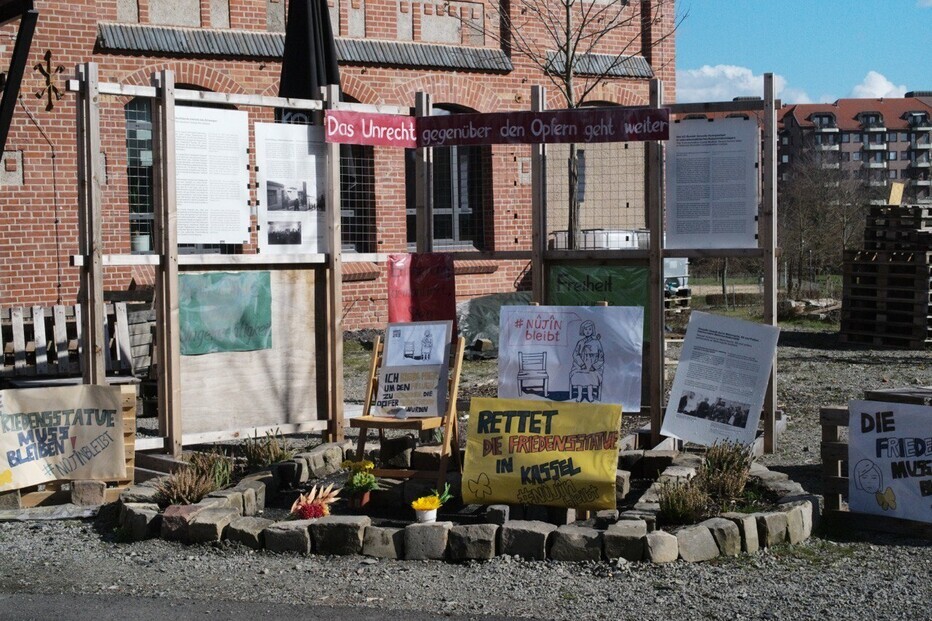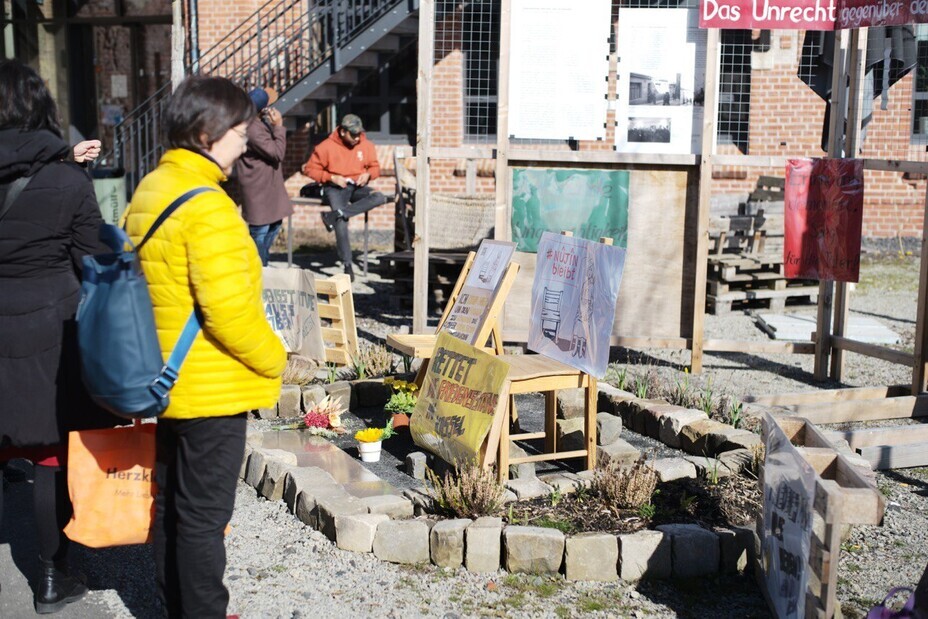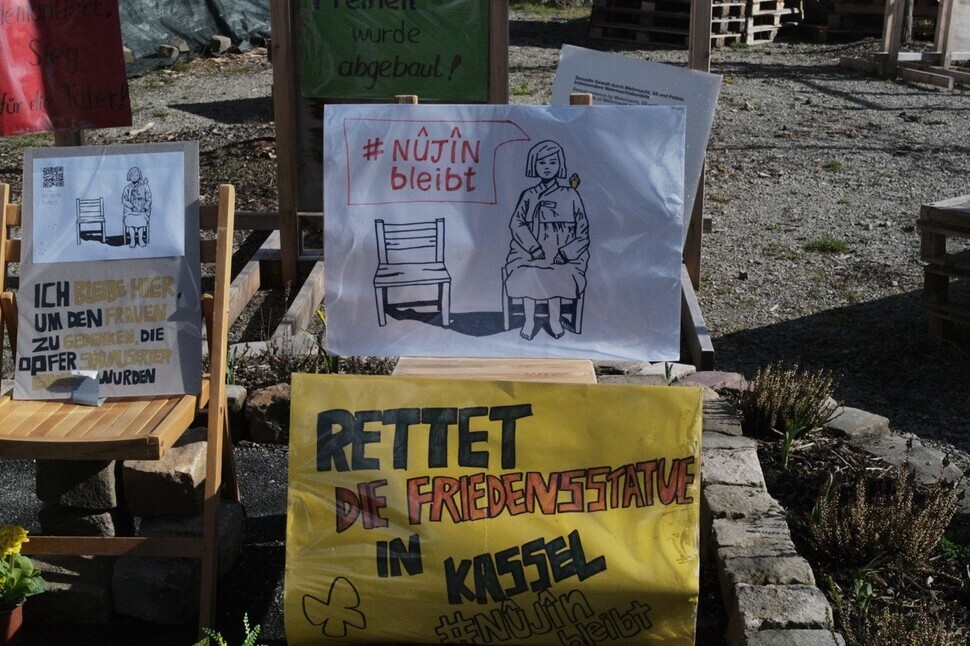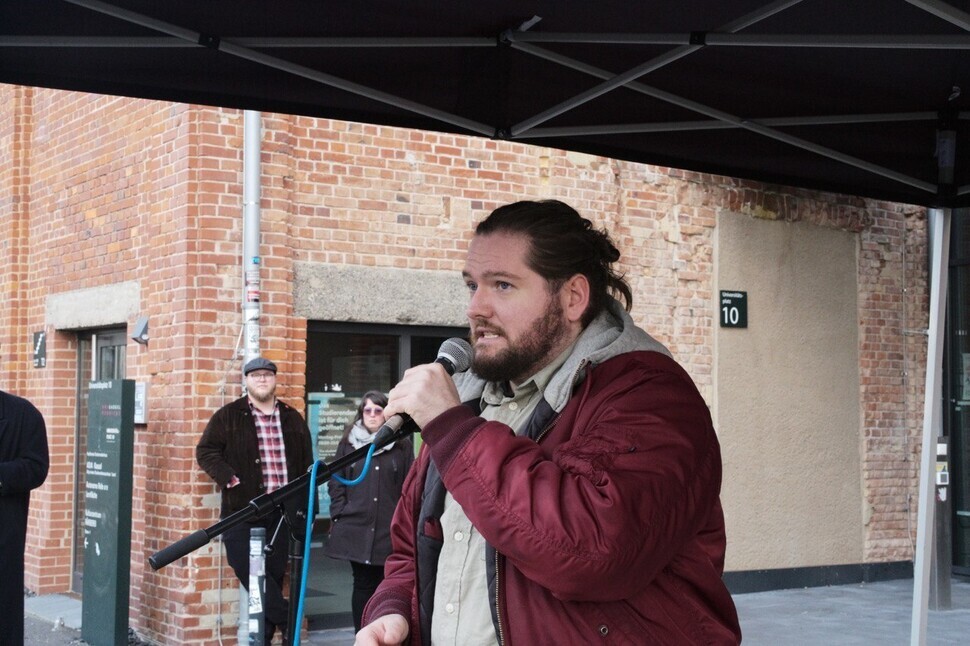hankyoreh
Links to other country sites 다른 나라 사이트 링크
[Reportage] German students rally to recover torn-down “comfort women” statue

She should have been sitting there on the grass in the warm sunshine — but she was nowhere to be found. Where the barefoot victim of wartime sexual slavery by the Japanese military once sat, signs were posted with the messages “Freedom has been torn down” and “When memories are taken away, that is a victory for the perpetrators.”
The only evidence that a Statue of Peace once stood here could be found in the images of her drawn by students and members of the public who had tried to protect her.
It was on March 9 — one day after International Women’s Day — that the University of Kassel, located in the central Germany state of Hesse, suddenly took down a statue honoring victims of the “comfort women” system that had been erected in front of the student union.

The statue had been raised in July of last year in front of the student union by the university’s student council, which had submitted a request to the Korea Verband, a civic group working on Korean issues in Germany.
The statue was given the name “Nûzîn” — meaning “new life” in Kurdish. The reason a Kurdish name was given to a statue symbolizing the comfort women was to emphasize how wartime sexual violence is a matter of universal, international human rights and colonialism, which transcends issues of bilateral relations between South Korea and Japan.
This also explains why the information posted where the statue had been taken down devoted more of its space to describing the military brothels operated by the Nazi armed forces during World War II.

At 4 pm on March 4, around 100 University of Kassel students and members of the public gathered in front of the student union building at the site where the statue had been taken down.
Two of the people joining in the calls to restore the statue to its original place were a 26-year-old Göttingen resident named Zaha and a 24-year-old student named Lisa, who said they had been keeping an eye on another Statue of Peace in Berlin.
Rallies took place not only in Kassel, but all over Germany — Berlin, Frankfurt and Hamburg — to condemn the university for suddenly taking down the statue without explanation.
“They must’ve taken the statue down in the night because no one saw them removing it. It feels like a punch to the face. It feels like a crime, like the statue was stolen from us.”
Lars Schäfer, 25, an executive member of Kassel’s student council, said that they still don’t know where the statue is now. The school has ignored students’ requests to talk and has yet to offer an official explanation for the removal. The only comment from the university authorities came in an online statement that said the statue was always a “temporary” one, and that “the permit has now expired.”
“The student council wants the statue back,” said Schäfer, “and we want to protect it.”

Tobias Schnoor, the former student body president who led the effort to install the statue last year, said at the rally that wartime sexual violence has “not only happened in Japan, but in Germany as well. It is also happening in the current war that Ukraine is fighting.”
“The Statue of Peace symbolizes that history,” he said, “but the university wants to get rid of it. Removing a statue installed in a space for students makes no sense.”
The rally was also attended by Heidemarie Scheuch-Paschkewitz, a member of the Left Party in Hesse, who said, “The Japanese government didn’t like the idea of placing the statue here because they didn’t want to be reminded of their colonialist history. The university should put the statue back in its place.”
It is believed that the university’s decision to remove the statue without consulting students was due to pressure from local Japanese diplomatic authorities. According to the University of Kassel’s former and current student councils, as well as Korea Verband, Japanese right-wingers and citizens have, by various means, continually put intense pressure on the university’s president and vice president to remove the statue since it was installed in July 2022.
When we asked Schnoor if he had received any direct letters, he stated that he “had two Japanese professors write to me directly, and when I didn’t respond, they became more aggressive.”
Sebastian Ehlers, who was vice-president of the University of Kassel’s student council when the council signed a permanent lease agreement with Korea Verband last year and is now president, told the Hankyoreh that “the university gave permission to install the Statue of Peace in a public place on campus after understanding the contents of the permanent lease agreement between the student council and Korea Verband.”

However, the university’s presidents decided to unilaterally remove the statue on March 9 after they formally requested its removal in late February. Students only realized that the statue had been removed after seeing the empty space where it once stood.
“The university’s sudden removal of the Statue of Peace makes me feel so heartbroken, as it reminds me of the history of women being forcibly taken as comfort women,” shared one overseas Korean.
It is unclear whether the students and locals will be able to return the statue back to its rightful place. Legally, universities have the authority to authorize the use of public space on campus.
Just as the statue in Berlin’s Mitte District was saved from demolition by public outcry, the fate of the statue in Kassel will depend on how many students and others demand that it be put back. Local residents and students are planning to organize a protest at the statue's site every Wednesday, under the name “Protecting the Statue of Peace.”
By Noh Ji-won, Berlin correspondent
Please direct questions or comments to [english@hani.co.kr]

Editorial・opinion
![[Column] Has Korea, too, crossed the Rubicon on China? [Column] Has Korea, too, crossed the Rubicon on China?](https://flexible.img.hani.co.kr/flexible/normal/500/300/imgdb/original/2024/0419/9317135153409185.jpg) [Column] Has Korea, too, crossed the Rubicon on China?
[Column] Has Korea, too, crossed the Rubicon on China?![[Correspondent’s column] In Japan’s alliance with US, echoes of its past alliances with UK [Correspondent’s column] In Japan’s alliance with US, echoes of its past alliances with UK](https://flexible.img.hani.co.kr/flexible/normal/500/300/imgdb/original/2024/0419/2317135166563519.jpg) [Correspondent’s column] In Japan’s alliance with US, echoes of its past alliances with UK
[Correspondent’s column] In Japan’s alliance with US, echoes of its past alliances with UK- [Editorial] Does Yoon think the Korean public is wrong?
- [Editorial] As it bolsters its alliance with US, Japan must be accountable for past
- [Guest essay] Amending the Constitution is Yoon’s key to leaving office in public’s good graces
- [Editorial] 10 years on, lessons of Sewol tragedy must never be forgotten
- [Column] A death blow to Korea’s prosecutor politics
- [Correspondent’s column] The US and the end of Japanese pacifism
- [Guest essay] How Korea turned its trainee doctors into monsters
- [Guest essay] As someone who helped forge Seoul-Moscow ties, their status today troubles me
Most viewed articles
- 1[Column] The clock is ticking for Korea’s first lady
- 2Samsung barricades office as unionized workers strike for better conditions
- 3After 2 months of delayed, denied medical care, Koreans worry worst may be yet to come
- 4[Correspondent’s column] In Japan’s alliance with US, echoes of its past alliances with UK
- 5[Column] Has Korea, too, crossed the Rubicon on China?
- 6Hong Se-hwa, voice for tolerance whose memoir of exile touched a chord, dies at 76
- 7[Photo] Smile ambassador, you’re on camera
- 8All eyes on Xiaomi after it pulls off EV that Apple couldn’t
- 9[Guest essay] How Korea turned its trainee doctors into monsters
- 10US overtakes China as Korea’s top export market, prompting trade sanction jitters